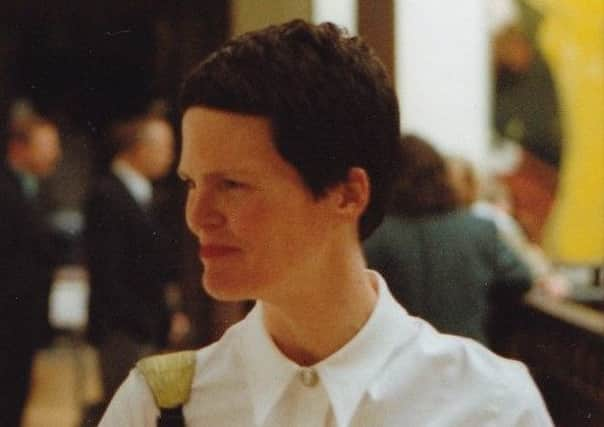Obituary: Carol Rhodes, Scottish artist whose ambiguous paintings speak of man's desire to govern the land


Carol Rhodes was one of the leading artists of her generation. Her paintings have been exhibited internationally and feature in major collections including Tate, the Arts Council, the British Council, Yale Centre for British Art and the Scottish National Gallery of Modern Art, where an exhibition of her work took place in 2007.
Rhodes’s parents were Church of Scotland missionaries who had been posted to India and her mother only returned briefly to Edinburgh in 1959, to give birth to Carol. They initially lived in Nagpur, then at the University of Serampore, near Kolkota, where her father taught theology. At the age of 12 she was sent to a missionary boarding school in the Himalayas.
Advertisement
Hide AdAdvertisement
Hide AdTwo years later, the family moved back to the UK, settling first in Sussex and then in Dumfries, where her father was a Minister.
From 1977 she studied painting at the Glasgow School of Art. She graduated in 1982 but stopped painting soon afterwards.
Rhodes’ parents were left-wing and growing up as a privileged European amid the poverty of Kolkota made her politically aware.
In the early 1980s she became active in Feminist politics, staying at the Peace Camp at Greenham Common. After graduating, Rhodes became involved with Glasgow’s Transmission Gallery, where in 1986 she became a committee member.
She worked part-time as a technician at Tramway and the Centre for Contemporary Art (CCA). Another part-time job involved helping the writer Alasdair Gray. She was also involved with the Free University of Glasgow, a forum for the free exchange of teaching skills.
Rhodes was keen to return to painting and in 1990 the opportunity came when a friend offered to share her studio space at Tramway in Glasgow.
She began painting single objects standing enigmatically in landscapes, but gradually the motifs disappeared and the landscape took over. Rhodes focused on the kinds of landscape we might glimpse from a car or train – the overlooked areas that lie between more dramatic sites.
She said that she became particularly aware of this kind of site when she was out and about, pushing a buggy, following the birth of her son, Hamish (to artist Richard Walker) in 1992.
Advertisement
Hide AdAdvertisement
Hide AdRhodes’s art matured quickly, and by 1994 all the tropes of her later work were in place: the subject matter, the aerial viewpoint, the absence of a horizon line, the fastidious brushwork.
Painting on small, square, meticulously primed MDF panels, she focussed on unpopulated landscapes of a very particular type: industrial estates, quarries, reservoirs, depots, car parks, airports. They are places where the man-made meets the untamed landscape.
Her paintings speak of man’s desire to govern the land: to flatten it and regiment it, to take stuff from it, store stuff on it, and dump stuff in it. They are landscapes that are made by us, for us, and they are, in every sense, about us. Each painting is a carefully judged marriage of precision and ambiguity. They are not political statements, or at least not overtly so, and she spoke of them in terms of colour, brushwork and composition.
Rhodes used a broad range of source material: photographs (some taken herself from a helicopter), travel and geography books, and a huge number of art books.
A painter’s painter, with a keen knowledge of the history of art, she admired the work of unfashionable artists such as Sassetta, Poussin, Chardin and Sickert. None of the landscapes in her paintings exists in reality: the final painting might be a fusion of landscape features from several different countries, re-crafted through the drawing process.
In 1994 Rhodes was included in the New Art Scotland show at the CCA, and she began showing at the Andrew Mummery Gallery in London from 1997. She taught at Glasgow School of Art from the mid-1990s until 2015.
A solo exhibition was held in the Tramway Project Room in 2000 and her mid-career retrospective at the Scottish National Gallery of Modern Art in 2007-08 was much admired. In hanging the show, Rhodes – who was precise, patient and co-operative to a fault – tried every picture in every possible permutation.
In 1996 she met the artist Merlin James, who would become her partner in 2004. In 2012 they set up an exhibition space at their home in Carlton Place, Glasgow.
Advertisement
Hide AdAdvertisement
Hide AdThat year, Rhodes experienced slight weakness in her knee; at the end of 2013 motor neurone disease was diagnosed. She began using a walking stick in 2014 and a wheelchair the following year. Her last paintings date from 2015. James rigged up a sling contraption in her studio, taking the weight off her arms and allowing her to finish a few last drawings in 2016.
She managed a trip to London in 2016, determined to see shows of the 18th-century watercolour artist Frances Towne at the British Museum and Winifred Knights at Dulwich Picture Gallery. An exhibition of her paintings took place at MAC Belfast in 2017, but she was unable to see it. A substantial monograph on Rhodes, edited by Andrew Mummery, was launched earlier this year at the Glasgow School of Art and shortly afterwards at galleries in New York and London.
In the last year of her life Rhodes communicated via an Eye Gaze Communication System, which tracked the movements of her eye over a screen keyboard. In August the Konch recording project invited her to read a poem. They did not know that she could not speak. The love poem by Dante that she chose, spoken movingly, in uneven bursts via a younger, synthesised voice, can be found on the web.
Carol Rhodes died peacefully at home and is survived by her son, Hamish, by her mother, Helen, and by her partner, Merlin James.
Patrick Elliott